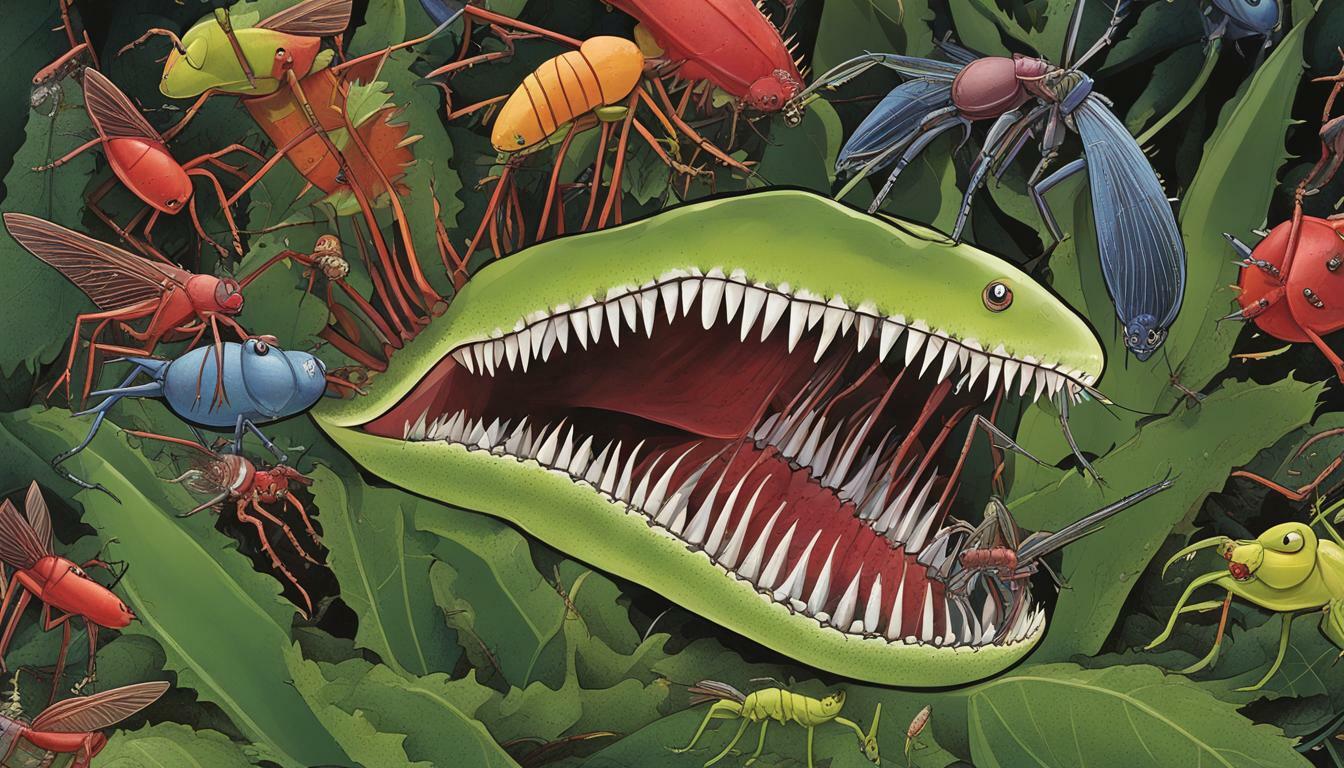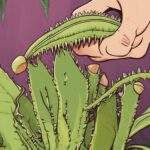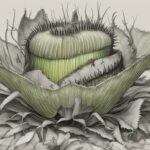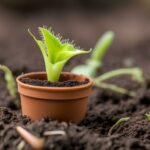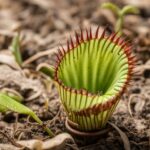Venus flytraps are fascinating carnivorous plants renowned for their ability to capture insects with their modified leaves. When most people think of Venus flytraps, they imagine them trapping and consuming flies, but do they exclusively eat flies? In this section, we will explore the diet of Venus flytraps, the sources from which they obtain nutrients, and their feeding habits to answer this question.
Key Takeaways:
- Venus flytraps are carnivorous plants that capture insects with their modified leaves.
- The diet of Venus flytraps is not limited to flies, and they consume a variety of prey.
- Venus flytraps obtain nutrients through digestion and absorption of captured prey.
- Feeding habits of Venus flytraps are heavily influenced by environmental factors.
The Diet of Venus Flytraps
Venus flytraps are famous for their carnivorous nature, and while they primarily consume insects, their diets can include a wide variety of prey.
While flies make up a significant portion of their meals, Venus flytraps have been known to consume ants, spiders, beetles, and other small invertebrates. They have even been observed capturing and eating small frogs and salamanders in their native habitats.
The diversity of their diet is crucial to their growth, with different prey items providing essential nutrients such as nitrogen, phosphorus, and potassium.
In addition to their prey, Venus flytraps have also been known to supplement their diet with other sources of nutrition. They can absorb nutrients from minerals in the soil and even from the bodies of dead insects caught in their traps.
Overall, the diet of Venus flytraps is far from exclusive to flies, and their ability to adapt to various food sources is part of what makes them such fascinating carnivorous plants.
Carnivorous Nature of Venus Flytraps
Have you ever heard of carnivorous plants? Venus flytraps are one type of carnivorous plant that have evolved to consume living organisms. These insect-eating plants obtain nutrients from their prey, which contributes to their growth.
But why have Venus flytraps become carnivorous? The primary reason is that they grow in nutrient-poor environments, such as bogs and wetlands. The soil in these areas lacks the necessary nutrients for plants to thrive, so Venus flytraps have adapted to capture and digest insects as their primary source of nutrition.
In addition to flies, Venus flytraps have been known to consume other small insects such as ants, beetles, and spiders. They even have the ability to capture and consume small frogs and salamanders, though this is rare.
Despite being carnivorous, Venus flytraps still rely on photosynthesis for energy production. They only capture and digest insects to supplement their nutrient intake in order to survive in their unique environments.
Overall, the carnivorous nature of Venus flytraps is what makes them such fascinating plants. Their adaptation to consuming living organisms and their unique feeding mechanisms have captured the attention of scientists and nature enthusiasts alike.
Feeding Mechanisms of Venus Flytraps
Venus flytraps obtain nutrients primarily through the consumption of insects, which they capture with their unique traps. These traps consist of modified leaves with sensitive trigger hairs that, when stimulated, cause the trap to close around the prey. Once trapped, the plant secretes digestive enzymes that break down the insect’s soft tissues, releasing essential nutrients.
The absorption of nutrients occurs mainly through small hair-like structures called trichomes located on the inner surface of the trap. These trichomes absorb the nutrient-rich fluids produced by the digestion of the insect, which are then transported to the rest of the plant to support growth and development.
It is important to note that Venus flytraps do not solely rely on insects for nutrition. They also absorb nutrients from the soil and from decomposing organic matter, although these additional sources of nutrition are minimal compared to the nutrients obtained through the consumption of insects.
| Feeding Mechanisms of Venus Flytraps |
|---|
| Venus flytraps capture insects with their unique traps consisting of modified leaves with sensitive trigger hairs. |
| The plant secretes digestive enzymes that break down the insect’s soft tissues, releasing essential nutrients. |
| The absorption of nutrients occurs mainly through small hair-like structures called trichomes located on the inner surface of the trap. |
| Venus flytraps also absorb nutrients from the soil and from decomposing organic matter, although these additional sources of nutrition are minimal compared to the nutrients obtained through the consumption of insects. |
The feeding mechanisms of Venus flytraps are extraordinary and play a key role in their survival and growth. The ability to capture and digest insects allows these plants to thrive in environments where other plants struggle to survive, making them a fascinating and unique addition to any collection of flora.
Additional Sources of Nutrition for Venus Flytraps
Although Venus flytraps are known for their insect-eating habits, they may consume other sources of nutrition as well. In addition to flies, these carnivorous plants have been observed to consume ants, beetles, spiders, and other small crawling insects. They may also consume small snails and slugs.
Aside from their primary food source, Venus flytraps may utilize other sources of nutrients such as sunlight and minerals in the soil. Sunlight is crucial for photosynthesis, where the plant converts light energy into chemical energy to support its growth. For minerals, Venus flytraps absorb them through their roots, which are in direct contact with the soil.
It’s important to note that while Venus flytraps may consume other sources of nutrition, their diet primarily consists of insects. This is because they have evolved to thrive in nutrient-deficient soils, where insects provide the necessary nutrients for their survival.
- Venus flytrap diet: Their primary food source is insects, but they may consume other small crawling creatures.
- What do Venus flytraps eat?: Aside from flies, Venus flytraps may consume ants, beetles, spiders, small snails and slugs.
- Venus flytraps and their diet: Venus flytraps require a diet of live insects for their nutrient requirements.
- Feeding habits of Venus flytraps: Venus flytraps may also utilize other sources of nutrition such as sunlight and minerals in the soil.
Factors Influencing the Venus Flytrap Diet
While Venus flytraps are known for their carnivorous nature, their diet is not just limited to flies. Several factors can influence the feeding habits of these fascinating plants, resulting in a diverse range of food sources.
Environmental conditions are a significant factor in determining what Venus flytraps eat. These plants thrive in wet, boggy environments with poor soil. The availability of insects and other prey is also contingent on environmental factors. For instance, Venus flytraps are more likely to consume ants during the summer months when they are most abundant.
Seasonal variations and weather patterns also play a role. During the winter months, Venus flytraps enter a dormant stage, and their feeding habits slow down. Conversely, in the spring and summer, when insects are most active, Venus flytraps consume an increased amount of prey.
While flies make up the primary food source for Venus flytraps, they are opportunistic carnivores and will consume other prey items, such as spiders, beetles, and ants. Additionally, these plants can absorb nutrients from dead insects and other organic matter present in the soil.
Overall, Venus flytraps demonstrate remarkable adaptability when it comes to their diet. They can switch between a variety of food sources depending on environmental conditions and the availability of prey. Their feeding habits have evolved to ensure that they obtain the nutrients required for their growth and survival, making them one of the most captivating carnivorous plants in nature.
Conclusion
In conclusion, Venus flytraps are fascinating carnivorous plants that have captivated scientists and nature enthusiasts alike for their unique feeding habits. While they are known for their ability to trap and consume flies, these plants have a diverse diet that extends beyond just insects. As we have explored in this article, Venus flytraps can consume a variety of prey items, including spiders, ants, and beetles, among others. Additionally, these plants can obtain nutrients from sources other than prey, such as through their roots. Despite their ability to adapt to different food sources, the feeding habits of Venus flytraps are impacted by several factors, including environmental conditions and the availability of prey. These variations result in seasonal changes in their diet. Overall, Venus flytraps are remarkable plants that have evolved to survive and thrive in nutrient-poor soils by consuming living organisms. Whether you are a plant enthusiast or just curious about the natural world, Venus flytraps are a fascinating subject of study.How Can I Tell If My Venus Flytrap Is Hungry If It Only Eats Flies?
If your Venus Flytrap only consumes flies, you may wonder how to spot its hunger. Look for the telltale signs, often referred to as the venus flytrap’s hunger indicators. These include closed leaf traps, vibrant red interiors, and a sticky residue on the surface. When you notice these signs, it’s time to feed your plant to ensure its healthy growth.
FAQ
Q: Do Venus flytraps only eat flies?
A: No, Venus flytraps are carnivorous plants that primarily consume insects, but they can also capture and digest other small organisms such as spiders, ants, beetles, and even small frogs, if they come in contact with the plant’s trigger hairs.
Q: How do Venus flytraps obtain nutrients?
A: Venus flytraps obtain nutrients by digesting the prey they catch. When an insect or other small organism triggers the plant’s trap, it closes tightly, trapping the prey inside. The plant then secretes digestive enzymes to break down the prey, allowing it to absorb the nutrients it needs for growth.
Q: What are the feeding habits of Venus flytraps?
A: Venus flytraps have specialized leaves with trigger hairs that, when touched by an insect, initiate the trapping process. The leaves close rapidly, enclosing the prey and preventing its escape. The plant then releases digestive enzymes to break down the prey over several days, absorbing the nutrients before reopening its leaves.

